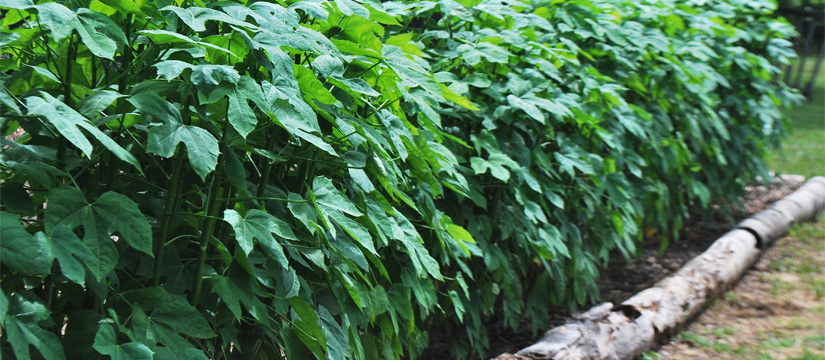Featured in the photo above is Chaya (Cnidoscolus aconitifolius), a miracle plant with true potential for the poor. The leaves of this long lived shrub are eaten as a nutritious vegetable that packs a punch of nourishment to those who consume it. Chaya leaves contain very high amounts of the vitamins and minerals that malnourished people lack the most.,much higher in many nutrients than spinach. The plant grows throughout nearly all the tropical regions where malnourishment and hunger are most prevalent, including highly humid and arid scenarios. Chaya is even flexible enough to thrive on our property in Central, FL where it is zapped back to the ground each year by freezing temperatures.
Chaya leaves are a very adaptable vegetable for the kitchen, representing a hardy and nutritious addition to soups, stir frys or any other number of meals that people are used to making. Once cooked, chaya maintains a dense texture something like collards. Chaya MUST be cooked sufficiently before consumption due to minorly toxic compounds that can lead to cyanide poisoning. If cooked for several minutes the cyanide content dissolves into the air, therefore it does not require the cooking water to be dumped. Most people find chaya to be a tasty addition to their meals.
While the minor toxic compounds in chaya leaves could easily be considered a curse, many realize it is a blessing in disguise in many situations. Pests and free ranging animals are reluctant to eat the raw leaves, allowing it to thrive in places where traditional vegetables may consistently fail.
Plants live many years, some reported to be well over thirty. If treated well when young they can be established quite quickly and begin providing food within a year. After the first year shrubs begin providing constant food throughout the entire year in most tropical settings. When leaves are harvested they are quickly replaced by new ones. In many cases having access to chaya during the dry season can give the poorest of the poor a nutrient rich food in a time generally defined by desolation. Unlike most vegetables, chaya only needs to be planted once and gives for years after with little or no effort. It is very tolerable of poor soils that the most vulnerable are left with to farm. New plants are easily started from cuttings and in some nations they have quickly dispersed across the countryside by the locals; a true sign of a successful plant introduction. After the first year one plant can become fifty plants, and so on. Many in the tropics have now come to rely on this consistent food source for basic nutrition needs. Great headway has been made but millions in the world still suffer from lack of basic nutritional compounds that chaya shrubs in the village could provide. Long hedgerows can quickly fill in to make a wall of food in current “food deserts.”
Remember the miracle of the chaya plant and the potential it offers to poor and vulnerable in warm climates. Plant more chaya, feed a hungry world!
post by Josh Jamison

